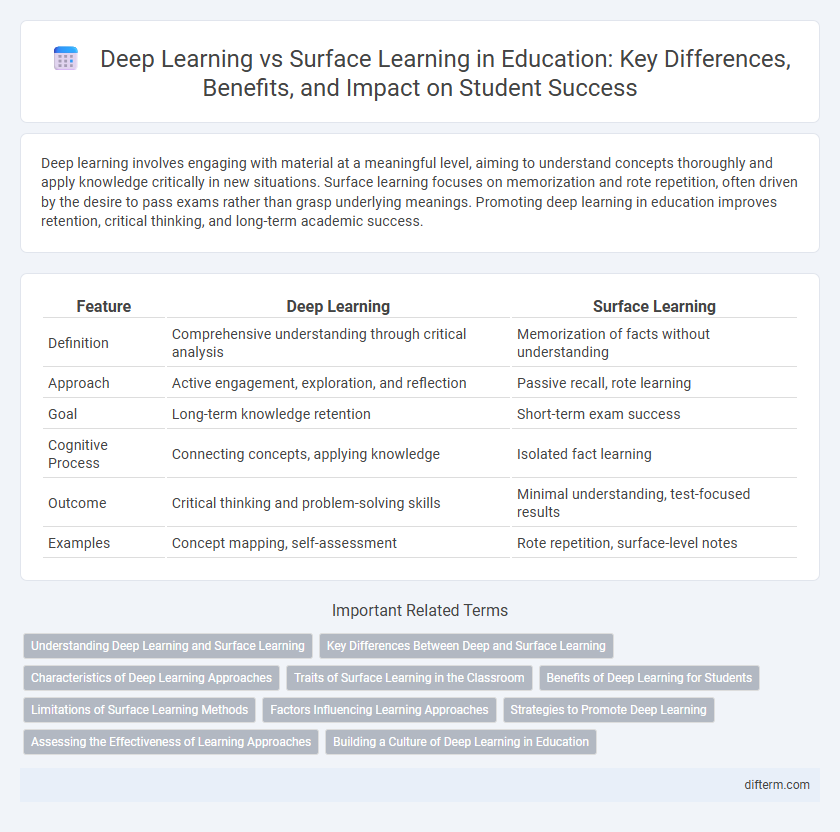Deep learning involves engaging with material at a meaningful level, aiming to understand concepts thoroughly and apply knowledge critically in new situations. Surface learning focuses on memorization and rote repetition, often driven by the desire to pass exams rather than grasp underlying meanings. Promoting deep learning in education improves retention, critical thinking, and long-term academic success.
Table of Comparison
| Feature | Deep Learning | Surface Learning |
|---|---|---|
| Definition | Comprehensive understanding through critical analysis | Memorization of facts without understanding |
| Approach | Active engagement, exploration, and reflection | Passive recall, rote learning |
| Goal | Long-term knowledge retention | Short-term exam success |
| Cognitive Process | Connecting concepts, applying knowledge | Isolated fact learning |
| Outcome | Critical thinking and problem-solving skills | Minimal understanding, test-focused results |
| Examples | Concept mapping, self-assessment | Rote repetition, surface-level notes |
Understanding Deep Learning and Surface Learning
Deep learning in education involves students actively engaging with material to develop critical thinking, conceptual understanding, and the ability to apply knowledge in various contexts. Surface learning emphasizes memorization and rote repetition, often leading to limited retention and shallow comprehension of content. Understanding the distinction between deep and surface learning helps educators design instructional strategies that promote meaningful and lasting educational outcomes.
Key Differences Between Deep and Surface Learning
Deep learning involves understanding concepts, critical thinking, and the ability to apply knowledge in new situations, while surface learning emphasizes memorization and rote repetition without true comprehension. Key differences include the motivation behind learning, with deep learners driven by curiosity and the desire to grasp meaning, contrasted with surface learners aiming to pass exams or complete tasks. Deep learning promotes long-term retention and transfer of knowledge, whereas surface learning often leads to shallow understanding and rapid forgetting.
Characteristics of Deep Learning Approaches
Deep learning approaches in education emphasize critical thinking, conceptual understanding, and the ability to apply knowledge across various contexts. These methods foster intrinsic motivation, encouraging learners to engage actively with material, make connections, and integrate new information with prior knowledge. Deep learning contrasts with surface learning by promoting long-term retention and the development of transferable skills essential for problem-solving and innovation.
Traits of Surface Learning in the Classroom
Surface learning in the classroom is characterized by rote memorization, minimal engagement with the material, and a focus on passing exams rather than understanding concepts deeply. Students relying on surface learning often prioritize short-term goals, such as recalling facts or procedures without grasping underlying principles. This approach leads to fragmented knowledge, reduced critical thinking skills, and poor application of knowledge in real-world contexts.
Benefits of Deep Learning for Students
Deep learning enables students to develop critical thinking and problem-solving skills by promoting a deeper understanding of material rather than rote memorization. This approach enhances long-term retention and application of knowledge across various subjects. Students engaging in deep learning become more autonomous, motivated, and capable of transferring skills to new contexts, improving academic performance and lifelong learning.
Limitations of Surface Learning Methods
Surface learning methods often prioritize rote memorization and superficial understanding, limiting students' ability to apply knowledge in unfamiliar contexts. This approach can hinder critical thinking and problem-solving skills, essential for mastering complex subjects. Consequently, learners may struggle with long-term retention and fail to develop deeper cognitive connections necessary for advanced academic success.
Factors Influencing Learning Approaches
Motivation, prior knowledge, and teaching methods significantly influence whether students adopt deep learning or surface learning approaches. Intrinsic motivation and meaningful engagement with content promote deep learning, leading to better comprehension and long-term retention. In contrast, external pressures and rote memorization often result in surface learning, which limits critical thinking and application skills.
Strategies to Promote Deep Learning
Implementing active learning techniques such as problem-based learning and collaborative group work encourages students to engage critically with content, fostering deep learning. Incorporating formative assessments with detailed feedback helps learners reflect on their understanding and identify areas for improvement. Designing curricula that emphasize real-world applications and integrative thinking supports long-term knowledge retention and conceptual mastery.
Assessing the Effectiveness of Learning Approaches
Evaluating the effectiveness of deep learning versus surface learning requires measuring outcomes such as knowledge retention, critical thinking skills, and application of concepts in real-world scenarios. Research indicates that deep learning fosters better long-term understanding and higher-order cognitive abilities, while surface learning often leads to short-term memorization without meaningful comprehension. Assessment methods like formative tests, project-based evaluations, and reflective journals effectively highlight the differences in how these learning approaches impact student performance and engagement.
Building a Culture of Deep Learning in Education
Building a culture of deep learning in education requires creating environments that prioritize critical thinking, conceptual understanding, and meaningful engagement with content over rote memorization. Educators must design curricula that challenge students to analyze, synthesize, and apply knowledge in real-world contexts, fostering intrinsic motivation and long-term retention. Institutional support, professional development, and assessment systems aligned with deep learning principles are essential to sustain this transformative approach.
deep learning vs surface learning Infographic

 difterm.com
difterm.com